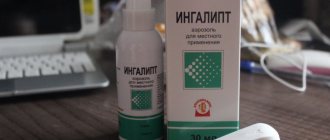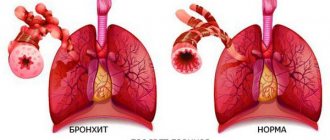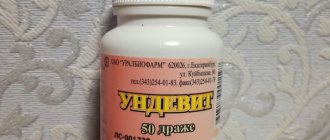Pharmacological properties
Pharmacodynamics
The mechanism of action of ibuprofen, a derivative of propionic acid from the group of non-steroidal anti-inflammatory drugs (NSAIDs), is due to inhibition of the synthesis of prostaglandins - mediators of pain, inflammation and hyperthermic reaction. Indiscriminately blocks cyclooxygenase 1 (COX-1) and cyclooxygenase 2 (COX-2), as a result of which it inhibits the synthesis of prostaglandins. It has a rapid, targeted effect against pain (analgesic), antipyretic and anti-inflammatory effects. Ibuprofen reversibly inhibits platelet aggregation.
Pharmacokinetics
Suction. Well absorbed from the gastrointestinal tract (GIT). The time to reach maximum concentration (TCmax) when taken on an empty stomach is 45 minutes, when taken after meals – 1.5–2.5 hours.
Distribution. Communication with plasma proteins – 90%. Slowly penetrates into the joint cavity, lingers in the synovial fluid, creating higher concentrations in it than in plasma.
Metabolism. Ibuprofen is metabolized in the liver primarily by hydroxylation and carboxylation of the isobutyl group. After absorption, approximately 60% of the pharmacologically inactive R form of ibuprofen is slowly transformed into the active S form.
Excretion. It has two-phase elimination kinetics, T1/2 is 1–2 hours. It is excreted by the kidneys (no more than 1% unchanged) and, to a lesser extent, with bile.
Indications for use
MAXICOLD® for CHILDREN is used from 3 months of life to 12 years as:
- antipyretic for acute respiratory diseases, influenza, childhood infections, post-vaccination reactions and other infectious and inflammatory diseases accompanied by an increase in body temperature.
- analgesic for pain of mild or moderate intensity, including: headaches and toothaches, migraines, neuralgia, pain in the ears and throat, pain with sprains and other types of pain.
The drug is intended for symptomatic therapy, reducing pain and inflammation at the time of use, and does not affect the progression of the disease.
Contraindications
According to the instructions, MAXICOLD® for CHILDREN should not be used for:
- hypersensitivity to ibuprofen, acetylsalicylic acid or other NSAIDs, as well as to other components of the drug;
- complete or incomplete combination of bronchial asthma, recurrent polyposis of the nose and paranasal sinuses and intolerance to acetylsalicylic acid or other non-steroidal anti-inflammatory drugs (including a history);
- ulcerative lesions of the gastrointestinal tract in the acute phase;
- gastrointestinal bleeding;
- a history of bleeding or perforation of a gastrointestinal ulcer caused by the use of NSAIDs;
- inflammatory bowel diseases in the acute phase (Crohn's disease, ulcerative colitis);
- active liver disease;
- progressive kidney diseases;
- severe hepatic, renal (creatinine clearance (CC) less than 30 ml/min) failure;
- confirmed hyperkalemia;
- severe heart failure, condition after coronary artery bypass grafting;
- bleeding disorders (including hemophilia, prolongation of bleeding time, bleeding tendency, hemorrhagic diathesis);
- intracranial hemorrhage;
- children up to 3 months;
- pregnancy (III trimester);
- fructose intolerance (as it contains maltitol).
MAXICOLD FOR CHILDREN oral suspension with strawberry flavor 200g 0.1MG/5ML
Maxicold for children should not be used if:
•hypersensitivity to ibuprofen. acetylsalicylic acid or other NSAIDs, as well as other components of the drug;
•complete or incomplete combination of bronchial asthma, recurrent polyposis of the nose and paranasal sinuses and
intolerance to acetylsalicylic acid or other non-steroidal anti-inflammatory drugs (including a history);
•ulcerative lesions of the gastrointestinal tract in the acute phase;
•gastrointestinal bleeding;
•a history of bleeding or perforation of a gastrointestinal ulcer caused by the use of NSAIDs;
•inflammatory bowel diseases in the acute phase (Crohn's disease, ulcerative colitis);
•active liver disease;
•progressive kidney diseases;
•severe hepatic, renal (creatinine clearance (CC) less than 30 ml/min) failure;
•confirmed hyperkalemia;
•severe heart failure, condition after coronary artery bypass grafting;
•blood clotting disorders (including hemophilia, prolongation of bleeding time, tendency to bleed, hemorrhagic diathesis);
•intracranial hemorrhage;
•children up to 3 months;
•pregnancy (III trimester);
• fructose intolerance (as it contains maltitol).
Carefully
You should consult your doctor before using Maxicold for children in the following situations:
simultaneous use of other NSAIDs;
diseases of the gastrointestinal tract (peptic ulcer of the stomach or duodenum, ulcerative colitis, Crohn's disease, history of bleeding),
liver, renal failure (creatinine clearance 30-60 ml/min);
•presence of Helicobacter pylori infection;
•simultaneous use of oral glucocorticosteroids (including prednisolone), anticoagulants (including warfarin),
antiplatelet agents (including clopidogrel), selective serotonin reuptake inhibitors (including citalopram, fluoxetine,
paroxetine, sertraline), antihypertensive drugs, diuretics, lithium drugs, methotrexate;
•bronchial asthma, urticaria;
•heart failure, arterial hypertension, cerebrovascular diseases, dyslipidemia/hyperlipidemia, diabetes mellitus,
peripheral arterial disease, fluid retention and edema;
•severe somatic diseases;
•systemic lupus erythematosus or other autoimmune connective tissue diseases (increased risk of developing aseptic meningitis);
•blood diseases of unknown etiology (leukopenia and anemia);
•pregnancy (1-11 trimester);
•lactation period.
Use during pregnancy and breastfeeding
The use of the drug is contraindicated in the third trimester of pregnancy. In the 1st and 11th trimesters of pregnancy, use of the drug
is possible only if the expected benefit to the mother outweighs the potential risk to the fetus.
An assessment of the expected benefits and potential risks should be carried out by a doctor.
It has been found that ibuprofen is detected in breast milk in very low concentrations.
The minimum detectable dose (0.0008% of the dose received) is unlikely to have an effect on the child
when breastfeeding. With long-term use of the drug or when using high doses, it may be advisable
temporary cessation of breastfeeding. To resolve the issue of the need to stop breastfeeding for a period
Use of the drug should consult a doctor.
Carefully
You should consult your doctor before using MAXICOLD® for CHILDREN in the following situations:
- simultaneous use of other NSAIDs;
- diseases of the gastrointestinal tract (peptic ulcer of the stomach or duodenum, ulcerative colitis, Crohn's disease, history of bleeding), liver, renal failure (creatinine clearance - 30–60 ml/min);
- presence of Helicobacter pylori infection;
- simultaneous use of oral glucocorticosteroids (including prednisolone), anticoagulants (including warfarin), antiplatelet agents (including clopidogrel), selective serotonin reuptake inhibitors (including citalopram, fluoxetine, paroxetine , sertraline), antihypertensive drugs, diuretics, lithium drugs, methotrexate;
- bronchial asthma, urticaria;
- heart failure, hypertension, cerebrovascular disease, dyslipidemia/hyperlipidemia, diabetes mellitus, peripheral arterial disease, fluid retention and edema;
- severe somatic diseases;
- systemic lupus erythematosus or other autoimmune connective tissue diseases (increased risk of developing aseptic meningitis);
- blood diseases of unknown etiology (leukopenia and anemia);
- pregnancy (I–II trimester);
- lactation period.
MAXICOLD SUSPENSION 100MG/5ML ORANGE 200ML
Caution should be exercised when using ibuprofen simultaneously with the following drugs: - Acetylsalicylic acid or other NSAIDs may increase the risk of side effects. Caution should be exercised if acetylsalicylic acid is taken for ischemic heart disease or cerebrovascular accidents, because ibuprofen may reduce the effect of acetylsalicylic acid. - Antihypertensive drugs: ibuprofen weakens the effect of antihypertensive drugs (including slow calcium channel blockers and ACE inhibitors). - Methotrexate: the elimination of methotrexate slows down. Patients with reduced renal function have a high risk of developing hepatotoxic reactions, even when using low doses of methotrexate (<20 mg/week). - Some antacids may reduce the absorption of ibuprofen from the gastrointestinal tract, which may be important during long-term use of ibuprofen. - Corticosteroids and selective serotonin reuptake inhibitors (including citalopram, fluoxetine, paroxetine, sertraline): increased risk of gastrointestinal bleeding. — Cyclosporine and gold preparations enhance the effect of ibuprofen on the synthesis of prostaglandins in the kidneys, which is manifested by an increased risk of nephrotoxicity. - Mifepristone: NSAIDs should be started no earlier than 8-12 days after taking mifepristone, as NSAIDs may reduce the effectiveness of mifepristone. - Tacrolimus: When ibuprofen and tacrolimus are used concomitantly, the risk of nephrotoxicity increases. — Zidovudine: simultaneous use of NSAIDs and zidovudine may lead to increased hematotoxicity. There is evidence of an increased risk of hemarthrosis and hematomas in HIV-positive patients with hemophilia who received concomitant treatment with zidovudine and ibuprofen. - Quinolone antibiotics: in patients receiving concomitant treatment with NSAIDs and quinolone antibiotics, there may be an increased risk of seizures. — The combined use of ibuprofen with cefamandole, cefoperazone, cefotetan, valproic acid, and plicamycin increases the incidence of hypoprothrombinemia. — Inducers of microsomal oxidation (phenytoin, ethanol, barbiturates, rifampicin, phenylbutazone, tricyclic antidepressants) increase the production of hydroxylated active metabolites, increasing the risk of developing severe hepatotoxic reactions. — Microsomal oxidation inhibitors reduce the risk of hepatotoxicity from ibuprofen. - Using ibuprofen together with thiazide diuretics reduces their effectiveness. — The drug enhances the side effects of mineralocorticosteroids and glucocorticosteroids. - Lithium: Ibuprofen slows down the elimination of lithium. - Cardiac glycosides: NSAIDs can increase the effects of heart failure, reduce the glomerular filtration rate and cause an increase in the level of glycosides in the blood plasma. — Caffeine enhances the analgesic effect. — Myelotoxic drugs increase the manifestations of hematotoxicity of the drug. - Drugs that block tubular secretion reduce excretion and increase plasma concentrations of ibuprofen. - Ibuprofen reduces the effectiveness of uricosuric drugs, enhances the effect of antiplatelet agents, fibrinolytics, thrombolytic drugs and insulin. - Cholestyramine reduces the absorption of ibuprofen.
Use during pregnancy and breastfeeding
The use of the drug is contraindicated in the third trimester of pregnancy. In the first and second trimesters of pregnancy, the use of the drug is possible only if the expected benefit to the mother outweighs the potential risk to the fetus. An assessment of the expected benefits and potential risks should be carried out by a doctor.
It has been found that ibuprofen is detected in breast milk in very low concentrations. The minimum detectable dose (0.0008% of the dose received) is unlikely to have an effect on the baby during breastfeeding. With long-term use of the drug or when using high doses, it may be advisable to temporarily stop breastfeeding. To decide whether it is necessary to stop breastfeeding while using the drug, you should consult a doctor.
Directions for use and doses
The drug is taken orally. 5 ml of the drug contains 100 mg of ibuprofen.
Shake the bottle thoroughly before use. To accurately measure the dose of the drug, use the included measuring spoon or dosing syringe.
If you are using a dosing syringe, follow these steps:
- Insert the dosing syringe firmly into the neck of the bottle.
- Shake the suspension well.
- Turn the bottle upside down and gently pull the plunger down, drawing the suspension into the dosing syringe to the desired mark.
- Return the bottle to its original position and remove the dosing syringe, gently turning it.
- Place the dosing syringe in the child's mouth and slowly press the plunger, smoothly releasing the suspension.
After use, rinse the dosing syringe in warm water and dry it out of the reach of children.
The dosage for children depends on the age and body weight of the child. A single dose is 5–10 mg/kg of the child’s body weight 3–4 times a day. The maximum daily dose should not exceed 30 mg per kg of body weight of the child per day. Do not exceed the indicated dose!
Dosing for pain and fever (high body temperature of the child)
| Child's age | Body mass | Dosing |
| 3–6 months | more than 5 kg | 2.5 ml 3 times within 24 hours, no more than 150 mg per day |
| 6–12 months | 6–10 kg | 2.5 ml 3-4 times within 24 hours, no more than 200 mg per day |
| 1–3 years | 10–15 kg | 5.0 ml 3 times within 24 hours, no more than 300 mg per day |
| 4–6 years | 15–20 kg | 7.5 ml 3 times within 24 hours, no more than 450 mg per day |
| 7–9 years | 21–29 kg | 10 ml 3 times within 24 hours, no more than 600 mg per day |
| 10–12 years | 30–40 kg | 15 ml 3 times within 24 hours, no more than 900 mg per day |
Dosage for post-immunization fever: 2.5 ml for children under 1 year of age. For children over 1 year of age, if necessary, an additional 2.5 ml every 6 hours. Do not use more than 5 ml within 24 hours!
The drug should be taken no more often than every 6 hours!
Duration of treatment:
- no more than 3 days as an antipyretic;
- no more than 5 days as a pain reliever.
If you need to take it for a longer period of time or if the drug is ineffective, you should consult your doctor.
Side effect
When using the drug, the following side effects may occur:
From the gastrointestinal tract: nausea, vomiting, feeling of discomfort or pain in the epigastrium, diarrhea, flatulence, constipation, erosive and ulcerative lesions, bleeding, exacerbation of ulcerative colitis and Crohn's disease, ulcerative stomatitis, impaired liver function, hepatitis, increased activity " liver" transaminases. From the nervous system: headache, dizziness, psychomotor agitation, insomnia, depression, aseptic meningitis (in patients with autoimmune diseases).
From the cardiovascular system: tachycardia, increased blood pressure, heart failure, myocardial infarction, stroke.
From the hematopoietic organs: anemia, thrombocytopenia, agranulocytosis, leukopenia, pancytopenia.
From the urinary system: impaired renal function, cystitis, papillary necrosis, acute renal failure, interstitial nephritis, peripheral edema, increased concentration of urea in the blood plasma. Allergic reactions: skin rash, itching, urticaria, exacerbation of bronchial asthma, angioedema, anaphylactoid reactions, anaphylactic shock, bronchospasm, fever, erythema multiforme exudative (including Stevens-Johnson syndrome), toxic epidermal necrolysis (Lyell's syndrome).
From the senses: blurred vision, hearing loss, ringing in the ears.
From the respiratory system: shortness of breath.
If these or other side effects occur, you should stop using the drug and consult a doctor.
Maxicold for children suspension for use 100 mg/5 ml 200 g No. 1 club with spoon
Composition: 1 tablet contains: ibuprofen 100.0 mg.
Excipients: polysorbate-80 (Tween 80) 0.5 mg, glycerol 600.0 mg, maltitol (liquid maltitol) 2111.25 mg*, sodium saccharinate 10.0 mg, citric acid monohydrate 20.0 mg, sodium citrate dihydrate (sodium citrate 2-water) 25.45 mg, xanthan gum (xanthan gum) 35.0 mg**, sodium chloride 5.5 mg. domiphen bromide 0.5 mg, strawberry flavor 12.5 mg, purified water up to 5 ml.
Note. *The cauldron contains liquid maltitol content.
Suspension from light gray or light gray with a yellowish tint to gray or gray with a yellowish tint with a characteristic fruity odor.
Pharmacological Action: A combined drug, the effect of which is determined by its constituent components.
Paracetamol is an analgesic-antipyretic that affects pain and thermoregulation centers. Has an analgesic and antipyretic effect. Reduces headaches, muscle pain, fever, and soothes sore throat.
Phenylephrine - has a vasoconstrictor effect, facilitates breathing through the nose and helps cleanse the nasal passages and paranasal sinuses.
Ascorbic acid is involved in the regulation of redox processes, carbohydrate metabolism, and increases the body's resistance to infections.
Indications for Use: Infectious and inflammatory diseases (ARVI, influenza), accompanied by high fever, chills, headache, joint and muscle pain, nasal congestion and pain in the throat and sinuses.
Method of Use: Pour the contents of 1 packet into a mug, pour hot water, stir until completely dissolved and drink hot.
Adults are prescribed 1 sachet every 4-6 hours. You should not take more than 4 sachets within 24 hours. You should not take the drug more often than every 4 hours.
Children over 12 years of age are prescribed 1 sachet every 6 hours. Do not take more than 3 sachets within 24 hours.
The patient should be warned that the drug is not recommended for use for more than 5 days as an analgesic and 3 days as an antipyretic. The doctor determines the need for longer use of the drug individually.
If symptoms persist despite use within the specified period, the patient should consult a doctor.
Interaction: Enhances the effects of MAO inhibitors, sedatives, ethanol.
Antidepressants, antiparkinsonian and antipsychotic drugs and phenothiazine derivatives increase the risk of urinary retention, dry mouth, and constipation.
GCS increase the risk of developing glaucoma. Paracetamol reduces the effectiveness of diuretics. Halothane increases the risk of ventricular arrhythmia. Phenylephrine reduces the hypotensive effect of guanethidine. Guanethidine enhances the alpha-adrenergic stimulating effect, and tricyclic antidepressants enhance the sympathomimetic effect of phenylephrine.
The risk of developing hepatotoxicity increases with simultaneous use of barbiturates, diphenine, carbamazepine, rifampicin, zidovudine and other inducers of microsomal liver enzymes.
Side Effects: Side effects caused by the action of paracetamol: allergic reactions are possible (skin rash, urticaria, angioedema); rarely - thrombocytopenia, leukopenia, agranulocytosis.
Side effects caused by the action of phenylephrine: possible nausea, headache, slight increase in blood pressure; rarely – palpitations (disappear after discontinuation of the drug).
With long-term use in doses significantly higher than recommended: increased risk of liver and kidney dysfunction.
Contraindications: - severe liver dysfunction;
- severe renal dysfunction;
— hyperthyroidism (thyrotoxicosis);
- heart disease (severe stenosis of the aortic mouth);
- acute myocardial infarction, tachyarrhythmias;
- arterial hypertension;
- simultaneous use of tricyclic antidepressants, beta-blockers, MAO inhibitors (including within 14 days after their withdrawal);
- simultaneous use of other paracetamol-containing drugs and drugs to relieve symptoms of colds, flu and nasal congestion;
- prostatic hyperplasia;
- angle-closure glaucoma;
- children under 12 years of age;
- hypersensitivity to the components of the drug.
Use with caution in the genetic absence of glucose-6-phosphate dehydrogenase, in benign hyperbilirubinemia, in renal or liver failure, diabetes mellitus and hereditary glucose malabsorption (contains glucose - 3 g), during pregnancy and lactation (breastfeeding), in elderly patients.
Overdose: The patient should be warned to seek immediate medical attention in case of overdose, even if feeling well, as there is a risk of delayed symptoms of serious liver damage.
Overdose is usually caused by the action of paracetamol.
Symptoms: possible pallor of the skin, anorexia, nausea, vomiting, increased activity of liver transaminases, hepatonecrosis, increased prothrombin time.
Treatment: gastric lavage, followed by the administration of activated charcoal; symptomatic therapy. A specific antidote for paracetamol poisoning is N-acetylcysteine.
Special Instructions: For patients taking metoclopramide, domperidone, cholestyramine, anticoagulants (warfarin), the doctor determines the need to prescribe Maxicold individually.
The doctor decides on an individual basis whether to prescribe the drug during pregnancy.
Patients should be informed that to avoid toxic liver damage, paracetamol should not be taken with alcohol.
It is not recommended to prescribe the drug to patients with chronic alcoholism.
Impact on the ability to drive vehicles and operate machinery
Since the active components of the drug do not have a sedative effect, when taken in recommended doses, there are no restrictions on driving a car or operating machinery.
Interaction with other drugs
Caution should be exercised when using ibuprofen simultaneously with the following drugs:
- Acetylsalicylic acid or other NSAIDs may increase the risk of side effects. Caution should be exercised if acetylsalicylic acid is taken for ischemic heart disease or cerebrovascular accidents, because ibuprofen may reduce the effect of acetylsalicylic acid.
- Antihypertensive drugs: ibuprofen weakens the effect of antihypertensive drugs (including slow calcium channel blockers and ACE inhibitors).
- Methotrexate: The elimination of methotrexate is slowed down. Patients with reduced renal function have a high risk of developing hepatotoxic reactions, even when using low doses of methotrexate (<20 mg/week).
- Some antacids may reduce the absorption of ibuprofen from the gastrointestinal tract, which may be important during long-term use of ibuprofen.
- Corticosteroids and selective serotonin reuptake inhibitors (including citalopram, fluoxetine, paroxetine, sertraline): increased risk of gastrointestinal bleeding.
- Cyclosporine and gold preparations enhance the effect of ibuprofen on the synthesis of prostaglandins in the kidneys, which is manifested by an increased risk of nephrotoxicity.
- Mifepristone: NSAIDs should be started no earlier than 8 to 12 days after taking mifepristone as NSAIDs may reduce the effectiveness of mifepristone.
- Tacrolimus: The risk of nephrotoxicity increases when ibuprofen and tacrolimus are used concomitantly.
- Zidovudine: Concomitant use of NSAIDs and zidovudine may result in increased hematotoxicity. There is evidence of an increased risk of hemarthrosis and hematomas in HIV-positive patients with hemophilia who received concomitant treatment with zidovudine and ibuprofen.
- Quinolone antibiotics: Patients receiving concomitant treatment with NSAIDs and quinolone antibiotics may have an increased risk of seizures.
- The combined use of ibuprofen with cefamandole, cefoperazone, cefotetan, valproic acid, and plicamycin increases the incidence of hypoprothrombinemia.
- Inducers of microsomal oxidation (phenytoin, ethanol, barbiturates, rifampicin, phenylbutazone, tricyclic antidepressants) increase the production of hydroxylated active metabolites, increasing the risk of severe hepatotoxic reactions.
- Microsomal oxidation inhibitors reduce the risk of hepatotoxicity from ibuprofen.
- Using ibuprofen with thiazide diuretics reduces their effectiveness.
- The drug enhances the side effects of mineralocorticosteroids and glucocorticosteroids.
- Lithium: Ibuprofen slows the elimination of lithium.
- Cardiac glycosides: NSAIDs can increase the effects of heart failure, reduce the glomerular filtration rate and cause an increase in the level of glycosides in the blood plasma.
- Caffeine enhances the analgesic effect.
- Myelotoxic drugs increase the manifestations of hematotoxicity of the drug.
- Drugs that block tubular secretion reduce excretion and increase plasma concentrations of ibuprofen.
- Ibuprofen reduces the effectiveness of uricosuric drugs, enhances the effect of antiplatelet agents, fibrinolytics, thrombolytic drugs and insulin.
- Cholestyramine reduces the absorption of ibuprofen.
Maxicold for children, 1 piece, 200 g, 100 mg/5 ml, oral suspension, orange flavor
Caution should be exercised when using ibuprofen simultaneously with the following drugs:
— Acetylsalicylic acid or other NSAIDs may increase the risk of side effects. Caution should be exercised if acetylsalicylic acid is taken for ischemic heart disease or cerebrovascular accidents, because ibuprofen may reduce the effect of acetylsalicylic acid.
- Antihypertensive drugs: ibuprofen weakens the effect of antihypertensive drugs (including slow calcium channel blockers and AIF inhibitors).
— Methotrexate:
the elimination of methotrexate slows down. Patients with reduced renal function have a high risk of developing hepatotoxic reactions, even when using low doses of methotrexate (<20 mg/week).
- Some antacids may reduce the absorption of ibuprofen from the gastrointestinal tract, which may be important during long-term use of ibuprofen.
- Corticosteroids and selective serotonin reuptake inhibitors (including citalopram, fluoxetine, paroxetine, sertraline): increased risk of gastrointestinal bleeding.
— Cyclosporine and gold preparations enhance the effect of ibuprofen on the synthesis of prostaglandins in the kidneys, which is manifested by an increased risk of nephrotoxicity.
- Mifepristone: NSAIDs should be started no earlier than 8-12 days after taking mifepristone, as NSAIDs may reduce the effectiveness of mifepristone.
- Tacrolimus: When ibuprofen and tacrolimus are used concomitantly, the risk of nephrotoxicity increases.
— Zidovudine: simultaneous use of NSAIDs and zidovudine may lead to increased hematotoxicity. There is evidence of an increased risk of hemarthrosis and hematomas in HIV-positive patients with hemophilia who received concomitant treatment with zidovudine and ibuprofen.
- Quinolone antibiotics: in patients receiving concomitant treatment with NSAIDs and quinolone antibiotics, there may be an increased risk of seizures.
— The combined use of ibuprofen with cefamandole, cefoperazone, cefogetane, valproic acid, plicamycin increases the incidence of hypoprothrombinemia.
— Inducers of microsomal oxidation (phenytoin, ethanol, barbiturates, rifampicin, phenylbutazone, tricyclic antidepressants) increase the production of hydroxylated active metabolites, increasing the risk of developing severe hepatotoxic reactions.
— Microsomal oxidation inhibitors reduce the risk of hepatotoxicity from ibuprofen.
- Using ibuprofen together with thiazide diuretics reduces their effectiveness.
— The drug enhances the side effects of mineralocorticosteroids and glucocorticosteroids.
- Lithium: Ibuprofen slows down the elimination of lithium.
- Cardiac glycosides: NSAIDs can increase the effects of heart failure, reduce the glomerular filtration rate and cause an increase in the level of glycosides in the blood plasma.
— Caffeine enhances the analgesic effect.
— Myelotoxic drugs increase the manifestations of hematotoxicity of the drug.
- Drugs that block tubular secretion reduce excretion and increase plasma concentrations of ibuprofen.
- Ibuprofen reduces the effectiveness of uricosuric drugs, enhances the effect of antiplatelet agents, fibrinolytics, thrombolytic drugs and insulin.
- Cholestyramine reduces the absorption of ibuprofen.
special instructions
The risk of developing undesirable effects can be minimized by using the minimum effective dose and short duration of therapy.
Before taking another NSAID drug, you should consult your doctor.
Patients should always inform their doctor of any symptoms that occur during therapy.
If symptoms of ulcerative lesions or bleeding from the gastrointestinal tract appear, the drug should be stopped, consultation with a doctor and careful monitoring of the condition is indicated, including esophagogastroduodenoscopy, a complete blood count with determination of hemoglobin, hematocrit, and a stool test for occult blood.
Precautions should be taken when simultaneously taking drugs that increase the risk of gastrointestinal complications (including bleeding), such as glucocorticosteroids or anticoagulants (warfarin, acetylsalicylic acid). (See Interactions with Other Medicines section.)
MAXICOLD® for CHILDREN can be used by children with diabetes mellitus, since the drug does not contain sugar. The drug is not recommended for use in patients with fructose intolerance, as it contains maltitol. Does not contain dyes.
Before starting therapy, patients with bronchial asthma or an allergic disease in the acute stage, as well as patients with a history of bronchial asthma/allergic disease, should consult a doctor, as the drug may provoke the development of bronchospasm.
Before starting to use the drug in patients with systemic lupus erythematosus or other autoimmune connective tissue diseases, it is necessary to consult a doctor, since the use of the drug is associated with an increased risk of developing aseptic meningitis.
Long-term therapy with the drug should be carried out under the supervision of a physician, with monitoring of the peripheral blood picture and the functional state of the liver and kidneys. Long-term use may increase the risk of acute coronary artery disease or stroke.
Before starting therapy, patients with a history of arterial hypertension and/or heart failure should exercise caution and consult a specialist, as fluid retention, hypertension and edema associated with NSAIDs have been noted in such patients.
During drug therapy, in very rare cases, hematopoiesis may be impaired. The first signs of hematopoietic disorders may be fever, sore throat, superficial ulcerations of the oral cavity, flu-like symptoms, severe weakness, nosebleeds, and hemorrhagic skin rashes. If these symptoms occur, you should stop taking the drug and consult a doctor.
The drug may affect the results of determining 17-ketosteroids, so it should be discontinued 48 hours before the test.
During the treatment period, ethanol intake is not recommended.
Maxicold suspension for internal use 100mg/5ml 200g strawberry
Compound
Per 5 ml:
Active substance: ibuprofen 100.0 mg.
Excipients: polysorbate-80 (Tween 80) 0.5 mg, glycerol 600.0 mg, maltitol (liquid maltitol) 2111.25 mg, sodium saccharinate 10.0 mg, citric acid monohydrate 20.0 mg, sodium citrate dihydrate ( sodium citrate 2-water) 25.45 mg, xanthan gum (xanthan gum) 35.0 mg, sodium chloride 5.5 mg. domiphene bromide 0.5 mg. strawberry flavor or orange flavor 12.5 mg, purified water up to 5 ml.
Note. The content of liquid maltitol is indicated. Depending on the viscosity of xanthan gum, it is possible to adjust its content in the preparation from 25.0 to 35.0 mg/5 ml.
Pharmacokinetics
Suction. Horonyu is absorbed from the gastrointestinal tract (GIT). Time to reach maximum concentration (TCmax) when taken on an empty stomach - 45 minutes, when taken after meals - 1.5-2.5 hours.
Distribution. Communication with plasma proteins - 90%. Slowly penetrates into the joint cavity, lingers in the synovial fluid, creating higher concentrations in it than in plasma.
Metabolism. Ibuprofen is metabolized in the liver primarily by hydroxylation and carboxylation of the isobutyl group. After absorption, approximately 60% of the pharmacologically inactive R form of ibuprofen is slowly transformed into the active S form.
Excretion. Has biphasic elimination kinetics. T1/2 is equal to 1-2 hours. It is excreted by the kidneys (no more than 1% unchanged) and, to a lesser extent, with bile.
Indications for use
Maxicold for children is used from 3 months of age to 12 years as:
- an antipyretic for acute respiratory diseases, influenza, childhood infections, post-vaccination reactions and other infectious and inflammatory diseases accompanied by an increase in body temperature.
- an anesthetic for pain of mild or moderate intensity, including: headaches and toothaches, migraines, neuralgia, pain in the ears and throat, pain with sprains and other types of pain. The drug is intended for symptomatic therapy, reducing pain and inflammation at the time of use, and does not affect the progression of the disease.
Contraindications
Maxicold for children should not be used if:
- hypersensitivity to ibuprofen. acetylsalicylic acid or other NSAIDs, as well as other components of the drug;
- complete or incomplete combination of bronchial asthma, recurrent polynosis of the nose and paranasal sinuses and intolerance to acetylsalicylic acid or other non-steroidal anti-inflammatory drugs (including a history);
- ulcerative lesions of the gastrointestinal tract in the acute phase;
- gastrointestinal bleeding;
- a history of bleeding or perforation of a gastrointestinal ulcer caused by the use of NSAIDs;
- inflammatory bowel diseases in the acute phase (Crohn's disease, ulcerative colitis);
- active liver disease;
- progressive kidney diseases;
- severe hepatic, renal (creatinine clearance (CC) less than 30 ml/min) failure;
- confirmed hyperkalemia;
— severe heart failure, condition after coronary artery bypass grafting;
- bleeding disorders (including hemophilia, prolongation of bleeding time, bleeding tendency, hemorrhagic diathesis);
- intracranial hemorrhage;
- children up to 3 months;
— pregnancy (III trimester);
- fructose intolerance (as soy contains maltitol).
With caution: You should consult a doctor before using Maxicold for children in the following situations:
- simultaneous use of other NSAIDs;
- diseases of the gastrointestinal tract (peptic ulcer of the stomach or duodenum, ulcerative colitis, Crohn's disease, history of bleeding),
- liver, kidney failure (creatinine clearance 30-60 ml/min);
— presence of Helicobacter pylori infection;
- simultaneous use of oral glucocorticosteroids (including prednisolone), anticoagulants (including warfarin), antiplatelet agents (including clopidogrel), selective serotonin reuptake inhibitors (including citalopram, fluoxetine, paroxetine, sertraline), antihypertensive drugs, diuretics, lithium drugs, methotrexate;
- bronchial asthma, urticaria;
- heart failure, arterial hypertension, cerebrovascular diseases, dyslipidemia/hyperlinidemia, diabetes mellitus, peripheral arterial disease, fluid retention and edema;
- severe somatic diseases;
- systemic lupus erythematosus or other autoimmune connective tissue diseases (increased risk of developing aseptic meningitis);
— blood diseases of unknown etiology (leukopenia and anemia);
— pregnancy (I-II trimester);
- lactation period.
Directions for use and doses
The drug is taken orally. 5 ml of the drug contains 100 mg of ibuprofen. Shake the bottle thoroughly before use. To accurately measure the dose of the drug, use the included measuring spoon or dosing syringe. If using a dosing syringe, follow these steps: 1. Insert the dosing syringe firmly into the neck of the bottle. 2. Shake the suspension well. 3. Turn the bottle upside down and gently pull the plunger down, drawing the suspension into the dosing syringe to the desired level. 4. Return the bottle to its original position and remove the dosing syringe, gently turning it. 5. Place the dosing syringe in the child's mouth and slowly press the plunger, smoothly releasing the suspension. After use, rinse the dosing syringe in warm water and dry it out of the reach of children. The dosage for children depends on the age and body weight of the child. A single dose is 5-10 mg/kg of the child’s body weight 3-4 times a day. The maximum daily dose should not exceed 30 mg per kg of body weight of the child per day. Do not exceed the indicated dose! Dosing for pain and fever (high body temperature of the child).
Dosage for post-immunization fever: 2.5 ml for children under 1 year of age. For children over 1 year of age, if necessary, an additional 2.5 ml every 6 hours. Do not use more than 5 ml within 24 hours! The drug should be taken no more often than every 6 hours! Duration of treatment: - no more than 3 days as an antipyretic - no more than 5 days as an analgesic. If you need to take it for a longer period of time or if the drug is ineffective, you should consult your doctor.
Storage conditions
Store at a temperature not exceeding 25 °C. Keep out of the reach of children.
Best before date
2 years. After the expiration date, the drug cannot be used.
special instructions
The risk of developing undesirable effects can be minimized by using the minimum effective dose and short duration of therapy. Before taking another NSAID drug, you should consult your doctor. Patients should always inform their doctor of any symptoms that occur during therapy. If symptoms of ulcerative lesions or bleeding from the gastrointestinal tract appear, the drug should be stopped, consultation with a doctor and careful monitoring of the condition is indicated, including esophagogastroduodenoscopy, a complete blood count with determination of hemoglobin, hematocrit, and a stool test for occult blood. Precautions should be taken when simultaneously taking drugs that increase the risk of gastrointestinal complications (including bleeding), such as glucocorticosteroids or anticoagulants (warfarin, acetylsalicylic acid) (see section “Interactions with other drugs”). Maxicold for children can be used for children with diabetes mellitus, because the drug does not contain sugar. The drug is not recommended for use in patients with fructose intolerance, as it contains maltitol. Does not contain dyes.
Before starting therapy, patients with bronchial asthma or an allergic disease in the acute stage, as well as patients with a history of bronchial asthma/allergic disease, should consult a doctor, as the drug may provoke the development of bronchospasm. Before starting to use the drug in patients with systemic lupus erythematosus or other autoimmune connective tissue diseases, it is necessary to consult a doctor, since the use of the drug is associated with an increased risk of developing aseptic meningitis.
Long-term therapy with the drug should be carried out under the supervision of a physician, with monitoring of the peripheral blood picture and the functional state of the liver and kidneys. Long-term use may increase the risk of acute coronary artery disease or stroke. Before starting therapy, patients with a history of arterial hypertension and/or heart failure should exercise caution and consult a specialist, as fluid retention, hypertension and edema associated with NSAIDs have been noted in such patients.
During drug therapy, in very rare cases, hematopoiesis may be impaired. The first signs of hematopoietic disorders may be fever, sore throat, superficial ulcerations of the oral cavity, flu-like symptoms, severe weakness, nosebleeds, and hemorrhagic skin rashes. If these symptoms occur, you should stop taking the drug and consult a doctor.
The drug may affect the results of determination of 17-ketosteroids, so it should be discontinued 48 hours before the test.
During the treatment period, ethanol intake is not recommended.
Description
Suspension from light gray or light gray with a yellowish tint to gray or gray with a yellowish tint with a characteristic fruity odor.
Conditions for dispensing from pharmacies
Over the counter.
Dosage form
Oral suspension [strawberry, orange].
Manufacturer and organization accepting consumer complaints
PHARMSTANDARD-LEKSREDSTVA, OJSC
Pharmacodynamics
The mechanism of action of ibuprofen, a derivative of propionic acid from the group of non-steroidal anti-inflammatory drugs (NSAIDs), is due to inhibition of the synthesis of prostaglandins - mediators of pain, inflammation and hyperthermic reaction. Indiscriminately blocks cyclooxygenase 1 (COX-1) and cyclooxygenase 2 (POG-2), as a result of which it inhibits the synthesis of prostaglandins. It has a rapid, targeted effect against pain (analgesic), antipyretic and anti-inflammatory effects. Ibuprofep reversibly inhibits platelet aggregation.
Side effects
When using the drug, the following side effects may occur:
From the gastrointestinal tract: nausea, vomiting, feeling of discomfort or pain in the epigastrium, diarrhea, flatulence, constipation, erosive and ulcerative lesions, bleeding, exacerbation of ulcerative colitis and Crohn's disease, ulcerative stomatitis, impaired liver function, hepatitis, increased activity " liver" transaminases.
From the nervous system: headache, dizziness, psychomotor agitation, insomnia, depression, aseptic meningitis (in patients with autoimmune diseases).
From the cardiovascular system: tachycardia, increased blood pressure, heart failure, myocardial infarction, stroke.
From the hematopoietic organs: anemia, thrombocytopenia, agranulocytosis, leukopenia, pancytopenia.
From the urinary system: impaired renal function, cystitis, papillary necrosis, acute renal failure, interstitial nephritis, peripheral edema, increased concentration of urea in the blood plasma. Allergic reactions: skin rash, itching, urticaria, exacerbation of bronchial asthma, angioedema, anaphylactoid reactions, anaphylactic shock, bronchospasm, fever, exudative erythema multiforme (including Stevens-Johnson syndrome), toxic epidermal necrolysis (Lyell's syndrome).
From the senses: blurred vision, hearing loss, ringing in the ears.
From the respiratory system: shortness of breath. If these or other side effects occur, you should stop using the drug and consult a doctor.
Use during pregnancy and breastfeeding
The use of the drug is contraindicated in the third trimester of pregnancy. In the first and second trimesters of pregnancy, the use of the drug is possible only if the expected benefit to the mother outweighs the potential risk to the fetus. An assessment of the expected benefits and potential risks should be carried out by a doctor.
It has been found that ibuprofen is detected in breast milk in very low concentrations. The minimum detectable dose (0.0008% of the dose received) is unlikely to have an effect on the baby during breastfeeding. With long-term use of the drug or when using high doses, it may be advisable to temporarily stop breastfeeding. To decide whether it is necessary to stop breastfeeding while using the drug, you should consult a doctor.
Interaction
Caution should be exercised when using ibuprofen simultaneously with the following drugs:
— Acetylsalicylic acid or other NSAIDs may increase the risk of side effects. Caution should be exercised if acetylsalicylic acid is taken for ischemic heart disease or cerebrovascular accidents, because ibuprofen may reduce the effect of acetylsalicylic acid.
- Antihypertensive drugs: ibuprofen weakens the effect of antihypertensive drugs (including slow calcium channel blockers and AIF inhibitors).
- Methotrexate: the elimination of methotrexate slows down. Patients with reduced renal function have a high risk of developing hepatotoxic reactions, even when using low doses of methotrexate (<20 mg/week).
- Some antacids may reduce the absorption of ibuprofen from the gastrointestinal tract, which may be important during long-term use of ibuprofen.
- Corticosteroids and selective serotonin reuptake inhibitors (including citalopram, fluoxegine, paroxetine, sertraline): increased risk of gastrointestinal bleeding.
— Cyclosporine and gold preparations enhance the effect of ibuprofen on the synthesis of prostaglandins in the kidneys, which is manifested by an increased risk of pephrotoxicity. - Mifepristone: NSAIDs should be started no earlier than 8-12 days after taking mifepristone, as NSAIDs may reduce the effectiveness of mifepristone.
- Tacrolimus: When ibuprofen and tacrolimus are used concomitantly, the risk of nephrotoxicity increases.
— Zidovudine: simultaneous use of NSAIDs and zidovudine may lead to increased hematotoxicity. There is evidence of an increased risk of hemarthrosis and hematomas in HIV-positive patients with hemophilia who received concomitant treatment with zidovudine and ibuprofen.
- Quinolone antibiotics: in patients receiving concomitant treatment with NSAIDs and quinolone antibiotics, there may be an increased risk of seizures.
— The combined use of ibuprofen with cefamandole, csfoperazone, cefogetane, valproic acid, and plicamycin increases the incidence of hypoprothrombinemia.
— Inducers of microsomal oxidation (phenytoin, ethanol, barbiturates, rifampicin, phenylbugazone, tricyclic antidepressants) increase the production of hydroxylated active metabolites, increasing the risk of developing severe hepatotoxic reactions.
— Inhibitors of microsomal oxidation reduce the risk of hepatotoxic effects of ibuprofen.
- Using ibuprofen together with thiazide diuretics reduces their effectiveness. The drug enhances the side effects of mineralocorgicosteroids and glucocorticosteroids.
- Lithium: Ibuprofen slows down the elimination of lithium.
- Cardiac glycosides: NSAIDs can increase the effects of heart failure, reduce the glomerular filtration rate and cause an increase in the level of glycosides in the blood plasma.
— Caffeine enhances the analgesic effect.
— Myelotoxic drugs increase the manifestations of hematotoxicity of the drug.
- Drugs that block tubular secretion reduce excretion and increase plasma concentrations of ibuprofen.
- Ibuprofen reduces the effectiveness of uricosuric drugs, enhances the effect of antiplatelet agents, fibrinolytics, thrombolytic drugs and insulin.
- Cholestyramine reduces the absorption of ibuprofen.
Overdose
If you accidentally exceed the recommended dose, consult your doctor immediately.
Symptoms of overdose: abdominal pain, nausea, vomiting, headache, tinnitus, metabolic acidosis, coma, acute renal failure, decreased blood pressure, bradycardia, tachycardia.
Treatment: gastric lavage (only within an hour after administration), activated charcoal, alkaline drinking, forced diuresis, symptomatic therapy.
Impact on the ability to drive vehicles and operate machinery
Patients who notice the occurrence of dizziness, headache or visual impairment while taking ibuprofen are advised to refrain from driving vehicles and engaging in other potentially hazardous activities that require increased concentration, speed of psychomotor and motor reactions.








